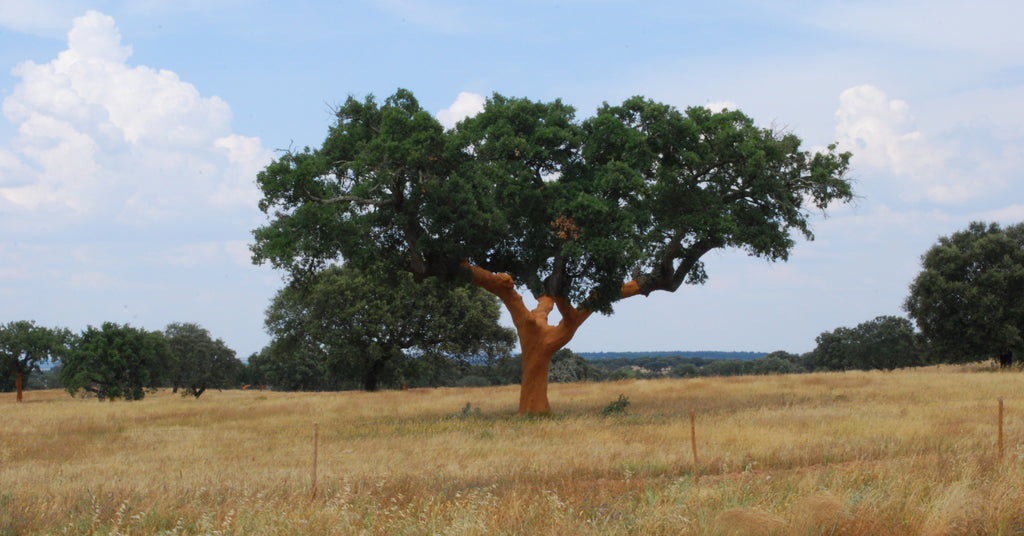Cork Fabric in India and Sustainability

In recent years, there have been growing concerns regarding the textile industry's impact on the environment. Many fashion brands have moved away from using animal and synthetic materials and constantly look to make their products more eco-friendly.
One such sustainable and vegan fabric that has started to pop up recently is cork. There are endless reasons why we, at Clan Earth, love cork and use it to handcraft our products. It is more than just vegan and eco-friendly. It is smooth, durable, and versatile with great functional value. Want to know why we are obsessed with this vegan and sustainable material? Keep reading on!
What is cork made of?

Cork comes from the bark of the cork oak tree, also known as Quercus Suber, and is found in Mediterranean regions, Spain, Portugal, and France. It is made by manually harvesting the bark and turning them into sheets by pressing. The entire process is sustainable from start to end and doesn't cause any damage to the tree; rather, it enriches its growth.
The production of cork fabric can be divided into 3 stages: Harvesting, Treatment of cork bark and turning into fabric.
Harvesting:
When the cork tree reaches 25 years of age, its bark can be stripped off. This process does not involve cutting the tree; instead, it is harvested from the trunk only by skillful harvesters. Cork tree allows harvesting once every 9 years. So once the bark is collected from a tree, it is marked with the year so the tree can grow back its bark, and harvesting can be repeated after 10 years.
Treatment of the bark:
After harvest, cork barks are stacked in piles and left outside to dry in the sun. After a few months of drying, the cork reaches the factory for processing. The cork is boiled in water to remove all the fungus and dirt. Unlike other materials, no chemicals are used in the processing of cork. Next, the cork is kept to dry for more weeks, and then it's cut in regular shapes of around 45 to 25 cm.

Tuning in to the fabric:
Only the middle section of cork, which is of the best quality, is used for textile. The cork is finely sliced into three layers. The middle layer is treated further for fabric while other layers are turned into products.
The middle layer is sliced again with a thickness of 0.3 to 0.4 mm. Then these thin layers of cork are glued to a cotton/polyester backing as they will easily break without the backing. Then, the cork sheet is pressed and coated with a sealant to give it a smooth and soft texture. Now, it can be dyed in different colors and used by manufacturers and designers like any other fabric.
What makes cork eco-friendly and sustainable?
Cork fabric is nature's most sustainable material not only because it's harvested without harming the tree- but its production doesn't cause any damage to the planet. Interestingly, the removal of its outer layers of the bark stimulates the regeneration of the cork and helps the tree become healthier. The ability to obtain cork repeatedly without causing any damage makes it a genuinely sustainable renewable resource. The total lifetime of an oak tree can be up to 300 years, allowing us to repeat the harvest over 16 times and providing over 1.5 tonnes of cork. Cork processing requires only water with no chemical or toxic residues, producing no environmental damage. Another great benefit of using cork is its ability to remove CO2 from the atmosphere.
Features of cork fabric:

Cork is more than just eco-friendly and vegan; its properties make it a highly versatile and functional material today. Here are a few reasons why cork is our prime choice -
Extreme lightness: Cork is exceptionally lightweight, with over 50% of its air volume. This makes it a perfect eco-friendly material for wallets and purses.
Water resistance: Cork is a completely waterproof material. Its cell contains suberin, a wax-like material that makes cork impermeable.
Wear and tear resistance: Cork is very sturdy and lasts for a lifetime. Its honeycomb structure makes it resistant to abrasion and allows it to hold its shape.
Soft and smooth texture: Cork fabric has a unique soft and smooth texture, making it an ideal material for making classy-looking carry accessories.
Cork and climate change
The cork tree is a natural CO2 retainer, a significant cause of global warming. Cork tree forests in Portugal, also known as montados, alone, retain up to 14 million tons of Co2. Unlike other trees, harvesting the bark of an oak tree boosts its carbon absorption. This means the more you harvest, the more it protects the environment. Cork trees also play an essential role in providing habitat for many rare and endangered species. The Portuguese cork forest is home to around 135 plant species and 42 bird species, many of which are endangered or critically endangered.
Now that you have learnt about this wonderful material, why not experience it by trying out the products we have made. Check out some of the sleekest and most minimal wallets and purse made of cork below!


